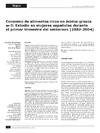Please use this identifier to cite or link to this item:
https://accedacris.ulpgc.es/handle/10553/43881
| Title: | Consumo de alimentos ricos en ácidos grasos omega-3: estudio en mujeres españolas durante el primer trimestre del embarazo (2002-2004) | Other Titles: | Consumption of foods rich in ω-3 fatty acids: A survey on Spanish pregnant women during the first trimester of pregnancy (2002-2004) | Authors: | Álvarez Pérez, Jacqueline Fernández Ballart, Joan D. Serra Majem, Luis |
UNESCO Clasification: | 3206 Ciencias de la nutrición 320108 Ginecología |
Keywords: | Docosahexaenoic Acid Chain Ácidos grasos omega-3 Embarazo Consumo alimentario |
Issue Date: | 2008 | Journal: | Revista Española de Nutrición Comunitaria | Abstract: | Objective: To know the frequency food consumption that is fatty acid source w-3 (EPA and DHA) in Spanish pregnant women during the first trimester of the gestation. Materials and Methods: Descriptive study was conducted in eight hundred and eighty eight pregnant women in the first trimester of pregnancy coming from the Centers of Health of eigtheen Spanish provinces were interviewed during period 2003-2004. The doctors and/or matrons made an interview that included the socioeconomic data and a questionnaire of frequency of food consumption. Results: The average age was of 32.1 years (D.E.: 4.67) in a rank of 16 to 48 years. The cold-water fish was located far distant of the first positions between the preferences of the pregnant women occupying the position number 21 with a 4% and the seventh place between the foods that less please with a 7%. Conclusions: In the population of pregnant women studied, the rich food ingestion in w-3, such as cold-water fish. fish, less consume it of once to the month more of a 40% of the women. The cold-water fish is not within foods preferred by the studied population and occupies the seventh position between the foods that less please. Objetivo: Conocer la frecuencia de consumo de alimentos que san fuente de ácidos grasas -3 (EPA Y DHA) en mujeres embarazadas españolas durante el primer trimestre de la gestación. Material y Métodos: Estudio de campo, descriptivo, en 888 mujeres embarazadas en el primer trimestre de gestación procedentes de los Centros de Salud de 18 provincias españolas, durante el período 2003-2004. Los médicos y/o matronas realizaron una entrevista que incluía los datos socio-económicos y un cuestionario de frecuencia de consumo de alimentos. Resultados: La edad media fue de 32,1 años (D.E.: 4,67) en un rango de 16 a 48 años. El pescado azul quedó ubicado muy distante de los primeros puestos entre las preferencias de las mujeres embarazadas ocupando el puesto número 21 con un 4% y el séptimo lugar entre los alimentos que menos gustan con un 7%. Conclusión: En la población de embarazadas estudiada, la ingesta de alimentos ricos en omega-3, tales como los pescados azules, lo consumen menos de una vez al mes más de un 40% de las mujeres. El pescado azul no está dentro de los alimentos preferidos por la población estudiada y ocupa la séptima posición entre los alimentos que menos gustan. |
URI: | https://accedacris.ulpgc.es/handle/10553/43881 | ISSN: | 1135-3074 | Source: | Revista Espanola de Nutricion Comunitaria [ISSN 1135-3074] v. 14, p. 42-48 | URL: | http://dialnet.unirioja.es/servlet/articulo?codigo=2699917 |
| Appears in Collections: | Artículos |
Page view(s)
192
checked on Dec 30, 2023
Download(s)
182
checked on Dec 30, 2023
Google ScholarTM
Check
Share
Export metadata
Items in accedaCRIS are protected by copyright, with all rights reserved, unless otherwise indicated.
